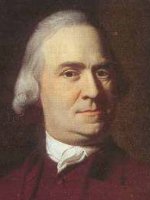 According to Samuel “Rat-trap” Adams, the wire-worker and former town crier, he:
According to Samuel “Rat-trap” Adams, the wire-worker and former town crier, he:- was six years old when the Stamp Act protests occurred, eleven in the year of the Boston Massacre, fourteen during the Tea Party, and sixteen in the first year of the war.
- helped the Sons of Liberty, reportedly by guarding the door when they had their meetings along with other boys.
- somehow served the Continental side during the Revolutionary War.
- conducted a prisoner from Worcester to Boston Jail during the Shays Rebellion.
- Ended up with a large striped banner that had been flown from a pole beside Liberty Tree when Boston’s Sons of Liberty had their meetings, which has since become known as the “Sons of Liberty flag.”
Liberty Tree was felled late in the summer of 1775, during the siege of Boston. That means this Samuel Adams’s connection to the tree has to date from his teens, well before he came of age. By what means did he become the keeper of the Sons of Liberty’s flag?
All signs point to Adams having grown up in the North End. Liberty Tree was far down in the South End. Rivalry between North End and South End gangs turned violent on most Pope Nights. So how easy would it have been for Adams to guard a door down on Essex Street?
Almost all the reports of a flag on the pole at Liberty Tree, mostly from the late 1760s, describe it as an ordinary British or “Union flag.” A Customs report said it was a “red flag,” which could have meant a red banner with the Union canton. No one described a flag with five red and four white stripes, which would have begged for interpretation.
When the Sons of Liberty raised their flag on their tall flagpole, sticking out above a tall elm tree, they were calling for a public meeting. They wanted masses of people. Often those gatherings were outdoors at the tree. The flag was not associated with closed-door strategy sessions that might need guarding.
Recent examination of the “Sons of Liberty flag” has found that it’s made from machine-woven cloth, which was rare in the 1760s and not made in America. Since a big part of the Boston Sons of Liberty tactics was to promote a boycott of goods imported from Britain, would they have chosen a rare British cloth for their banner?
Some descendants of this Samuel Adams said that he was the private of that name that Massachusetts Soldiers and Sailors lists as serving in Capt. Josiah Harris’s company, Col. William Bond’s regiment, in late 1775. All we know about that Samuel Adams is that he joined up in Charlestown, like many of the regiment’s other men. But Massachusetts Soldiers and Sailors has more than three pages of listings of men named Samuel Adams.
“Rat-trap” Adams lived long enough to apply for a federal pension based on Revolutionary service. We know he sought money from the state. But no Samuel Adams of Suffolk County appears on the lists of federal pensioners, and no one seems to have found an application from him describing his military experiences. So did he not serve long enough to qualify under any of the pension laws?
All told, Samuel Adams’s Revolution, how he came to possess the “Sons of Liberty flag,” and the origin of that flag remain shrouded in mystery. He and the banner definitely appeared at Boston historical commemorations and political rallies in the mid-1800s. They thus symbolize the radical reformers’ claim on the city’s Revolutionary heritage, along with every other political grouping. But “Rat-trap” Adams hasn’t convinced me we can say more than that.










